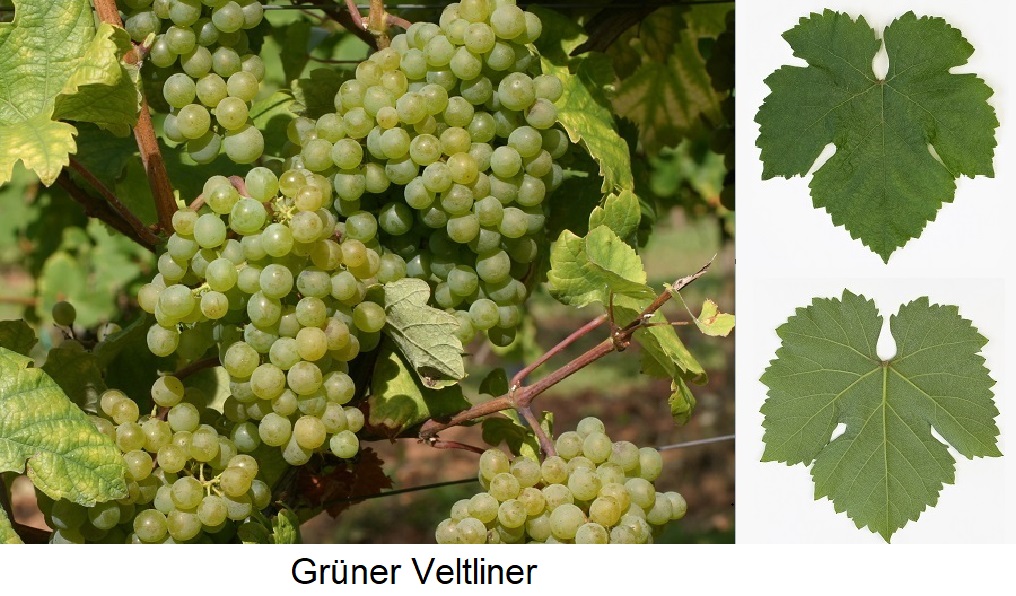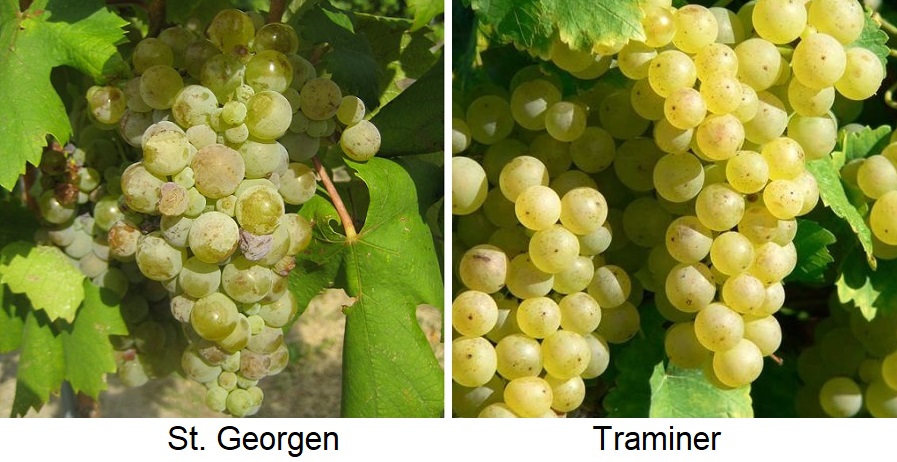The white grape variety originates from Austria. There are around 80 synonyms that testify to the vine's age and widespread distribution in Central Europe. The most important, grouped alphabetically by country, are Veltliner(Germany); Valtelin Blanc, Valteliner, Valteliner Blanc, Valteliner Vert, Veltliner Verde (France); Cima Bianca (Italy); Veltlinac Zeleni (Croatia); Gruner Veltliner (New Zealand); Dreimänner, Falkensteiner, Feldlinger, Grauer Veltliner, Grüner Manhardsrebe, Grüner, Grüner Muskateller, Grüner Weißgipfler, GrüVe, GV, Manhardsrebe, Manhardtraube, Manhartsrebe, Mauhardsrebe, Mouhardrebe, Veltliner, Weißer, Weißer Raifler, Weißer Reifler, Weißgipfler(Austria); Bielospicak, Veltlínské Zelené(Slovakia); Zeleni Veltlinec (Slovenia); Veltliner (South Tyrol); Tarant Bily, Veltlínské Zelené(Czech Republic); Fehérhegyue, Zoeld Veltelini, Zoeld Velteliny (Hungary).

Ancestry
Genetic characteristics indicate that the lead variety Roter Veltliner is probably an ancestor. DNA analyses carried out by biologist Dr Ferdinand Regner in 1998 identified Traminer as the parent variety. However, the second parent was still unknown until 2000, when a very old vine was discovered in the Burgenland municipality of St. Georgen. The previously unknown variety was named after the place where it was found, St. Georgen, and after DNA analyses carried out by Regner in 2007, it turned out to be the parent variety. In 2023, it was officially given the main name Mater Veltlinis. The variety Grüner Veltliner thus originates from a presumably natural cross between Mater Veltlinis (St. Georgen) x Traminer (Savagnin Blanc). According to DNA analyses, of the Grauer Veltliner variety is a mutation of Grüner Veltliner. The new variety Donauveltliner was created by crossing Grüner Veltliner x Seyval Blanc.

Veltliner varieties
Grüner Veltliner is only distantly related to most other Veltliner varieties, if at all. Hermann Goethe (1837-1911) already wrote in 1887 in his Handbuch der Ampelographie "that botanically it does not belong to the Velteliner family". The ethymological origin of "Veltliner" is unclear; among others, "Feldlinger" is mentioned. A frequently assumed reference to the Valtellina in Lombardy is in any case obsolete due to the clarified origin. The current name was first mentioned in 1855, but only finally became established in the 1930s. Before that, the variety was usually called "Weißgipfler" or "Grüner Muskateller", although it does not have a muscat flavour. The ampelographer Balthasar Sprenger (1724-1791) mentioned a "Grüner Muskateller" from Ödenburg in 1766, which corresponds to Grüner Veltliner.

There are around a dozen grape varieties with the name part "Veltliner", mostly in connection with a colour. Most of them are not or only distantly related to Grüner Veltliner; see a list under Veltliner.
Characteristics
The medium to late-maturing, high-yielding vine is susceptible to both types of mildew. It makes no great demands on specific soil types and thrives equally well on poor and fertile soils. The flexible variety is well suited to primary rock soils, such as in the Wachau and Kremstal, loess soils, such as in the Kremstal and Wagram, but also heavy loam and clay soils, such as in the Weinviertel. In terms of climate and soil, Austrian conditions are ideal. The variety produces fruity, spicy white wines with aromas of grapefruit, quince and apple and, with longer ageing, almond tones. The spicy flavour is known in Austria as ""Pfefferl"" in Austria. With appropriate ageing, it has good ageing potential. The classic Grüner Veltliner is mostly vinified "bone dry" in Austria, but is also used for the production of sweet Prädikat wines and sparkling wines. There are a large number of clones for the various requirements, one of the best known of which is the Mössmer clone.
Cultivation areas
In the middle of the 19th century, the variety was widespread in Austria around Retz in the Weinviertel, on the Brünner Straße and Horner Straße. There it displaced the mass-producer variety Weißer Heunisch (Gouais Blanc). Until the Second World War, however, Grüner Veltliner was not as important in Austria as it is today. It was only with the introduction of the high-culture cultivation method created by Austrian viticulture pioneer Lenz Moser III (1905-1978) that it spread rapidly from the 1950s onwards and became the dominant variety. With 14,423 hectares, the variety accounts for around a third of the total vineyard area.
The variety is cultivated in all Austrian wine-growing regions, especially in the "Veltliner-Land" (Weinviertel). The importance of Grüner Veltliner in Austria was emphasised here by the original wine Weinviertel DAC, first introduced in 2003, which was soon followed by others from this variety called Kamptal DAC, Kremstal DAC and Traisental DAC.
There are further stocks in Bulgaria, Germany (29 ha), France, Italy (55 ha), Croatia, Romania (0.1 ha), Switzerland (1 ha), Slovakia (1,627 ha), Slovenia, the Czech Republic (1,538 ha) and Hungary (1,381 ha). Overseas stocks exist in Argentina (7 ha), Australia (9 ha), Canada (3 ha), New Zealand (43 ha), South Africa (4 ha) and the USA (60 ha). In 2016, 19,918 hectares of vineyards were designated. This puts the variety in 42nd place in the global grape variety ranking (Kym Anderson).
Images: Ursula Brühl, Doris Schneider, Julius Kühn Institute (JKI)
Voices of our members

There is a vast number of sources on the web where one can acquire knowledge about wine. But none has the scope, timeliness and accuracy of the information in the encyclopaedia at wein.plus. I use it regularly and rely on it.
Sigi Hiss
freier Autor und Weinberater (Fine, Vinum u.a.), Bad Krozingen